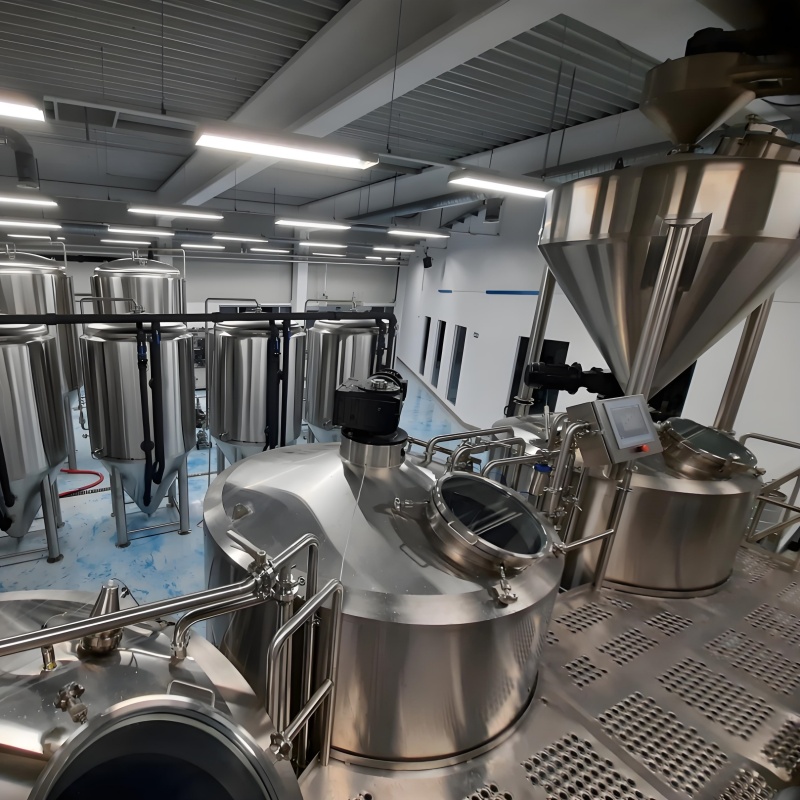Views: 0 Author: Site Editor Publish Time: 2025-08-23 Origin: Site











A commercial craft brewery equipment setup consists of several key components, each playing a crucial role in the brewing process. Below is a detailed description of each component:
Function: The malt miller is the first step in the brewing process, responsible for crushing the malted grains. This step is crucial for mashing efficiency, as it affects the extraction of sugars during the mashing process.
Design: Commercial malt grinders typically utilize a two- or four-roller design. These rollers can be adjusted to accommodate different types of malt, ensuring uniform grinding without over-crushing.
Features: Advanced grinders may be equipped with a dust cover to reduce dust and an automatic feeding system to improve efficiency and cleanliness.
Mash Tun:
Function: The mash tun mixes malt with water and heats it, converting starch into fermentable sugars. Features: Modern mash tuns are typically made of stainless steel, feature jacketed insulation, and are equipped with variable frequency agitators for uniform mixing. They also have automatic temperature control and a liquid level indicator for precise control.
Features: Lauter tuns are used to separate liquid wort from solid husks after mashing.
Features: They are designed to efficiently filter and collect clear wort, often equipped with rakes or knives to aid in the separation process.

Features: Brew Kettle are used to boil wort, sterilizing it and concentrating flavors. Hops are also added during the process, adding aroma and bitterness to the beer.
Features: Commercial brewers may be electrically or steam heated and often feature automated hop addition and foam control to streamline the process.
Whirlpool Tank:
Function: After boiling wort, it is transferred to the swirl tank, where solid particles (lees) are separated from the wort by rotation.
Feature: This process helps clarify the wort before cooling and fermentation.
Function: A plate heat exchanger quickly cools boiled wort to a suitable temperature for fermentation.
Design: It consists of a series of metal plates that transfer heat from the hot wort to a cooling medium (usually water or glycol), achieving efficient and rapid cooling.
Commercial breweries utilize a complex array of equipment and systems to optimize the brewing process, ensuring high-quality beer production machine and operational efficiency. At the heart of this process are stainless steel conical-bottom beer fermenters. These stainless steel fermenters are carefully designed for enhanced functionality and sanitation, featuring cooling jackets for precise temperature control, essential for maintaining optimal fermentation conditions. Additional features such as clean-in-place spray balls, sampling ports, pressure gauges, and degassing valves facilitate cleaning, monitoring, and operation.
CIP cleaning systems are crucial for maintaining the cleanliness and quality of the brewing environment. By circulating high-temperature alkali or acid solutions, or clean water, CIP systems effectively sanitize tanks and piping. These systems typically utilize a two- or three-tank configuration and centrifugal pumps to ensure thorough removal of residues and microorganisms, protecting the beer from contamination.
To ensure consistency and efficiency, commercial breweries often employ automated control Brewery systems. These systems, equipped with PLCs (programmable logic controllers) or touchscreen interfaces, enable precise control of various brewing parameters, such as mash temperature and pump speed. They can also initiate cleaning cycles at the touch of a button. Advanced control systems may also include data collection and remote monitoring capabilities, providing breweries with valuable insights and management tools.
For packaging, breweries can choose from semi-automated or fully automated filling lines. These systems streamline the bottling process, improve efficiency, and ensure beer is accurately filled into bottles or cans for distribution and sale. This automation speeds up production, reduces the risk of human error, and ensures that the end product consistently meets quality standards.
Each of these components is critical to ensuring the quality and consistency of beer produced by commercial craft brewery equipment. The integration of modern technologies in these systems improves the precision, efficiency, and consistency of the brewing process.if you are interested in the micro beer brewery equipment please contact ZPET freely.
